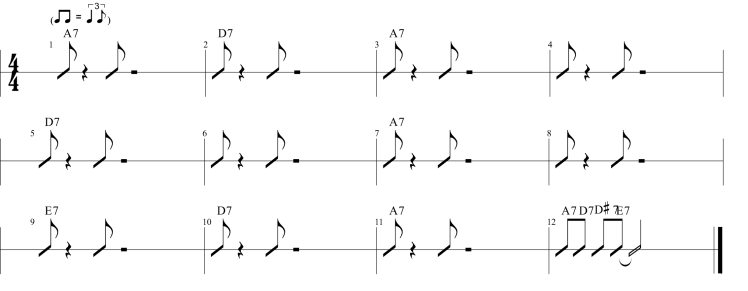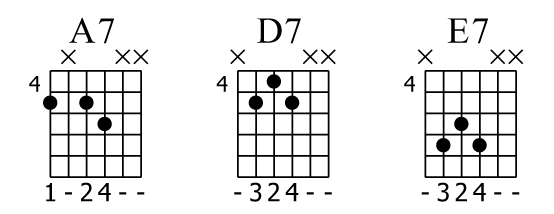Blues Guitar Comping
Playing On The Porch – How To Play Blues Guitar On Your Own
Lesson by Andi Saitenhieb.
Today we’ll look at comping by adding the sound of a horn section – played by ourselves on the guitar! Before we start to switch back and forth between lead lines accompaniment technique (in the next installment of this series), we need to take a closer look at this new concept itself.
The concept of Comping
A dominant seventh chord consists of the root, the major 3rd, the 5th the b7. The major third and the ‘flat’ seventh are the two most important notes in a seventh chord. The interval between these two notes is called a tritone (three whole steps or six half steps). If you don’t care about the theory behind it, that’s fine. Just memorise the chord shapes and where the root of the chord is!

Ex. 1 shows a simple one-bar motif that sounds like something a brass section would play in a Blues band. We are in the key of A and the chord shape consist of the root, the major third and the minor seventh of an A7 chord. Notice that these horn kicks are played staccato (staccato means “very short”.) Also notice the shuffle feel that is responsible for the second chord being played a little later than in a straight feel.
If you have problems with the rhythm of this example you should count along loud. I’ve written the count above the score.
Ex. 2 shows a chord shape for the IV-chord of our Blues progression (D7).

With these two chord shapes we are able to play a complete 12-bar Quick Change Blues progression: Move the IV-chord two frets up and you’ve got the V-chord. Here are the chord shapes with the fingering I suggest:
Note that second and forth finger just move up or down. They stay on the same strings and they also stay in the same position relative to each other.
Ex. 3 shows a complete 12-bar Blues progression with a Quick Change in the key of A with the aforementioned rhythm and chord shapes.
Audio PlayerWhy not try to make up some rhythms of your own with these chord shapes?
Using this concept in a band-setting
In a band-setting when a bass player is present, we can omit the root to stay out of the bass player’s territory. If we take a close look at the remaining notes (a tritone, by the way, (see above) we find that the IV and the V are the exact same shapes as the I, only moved one fret (down or up respectively). I usually use my index and ring finger for this chord shape. Here is another very common rhythm that is two bars long:

If you have a problem with the rhythm, try to pencil in the count like I showed you in Ex. 1. Break up the rests into 8th note rests. (A quarter rest equals two, a dotted quarter note rest three and a half rest four 8th note rests.)
Play a complete 12-bar Blues progression with these tritones. Try to ‘see’ the roots of the chords on the fretboard, even when you don’t play them.
Also try this comping-with-tritones-concept in different keys. If you feel comfortable, try to comp some of your favourite Blues songs on CD.
Adding Chromatism
Now we add some chromatism to jazz the comping up a bit. Basically we move the chord shape down one fret and then back up again from the off beat back onto the on beat. This is not a real chord change but more of an ornamentation of the underlying chord.
This time only the last tritone kick is played staccato. Play a complete 12-bar Blues with this riff.

Again make up some rhythms of your own, this time incorporating chromatic movement.
Tritones are easy to play, they sound great and they don’t get in anybody’s way. These little chord shapes are a GREAT way to accompany a Blues, whether you play on your own or with other musicians!
If you want to learn more concepts like this you can check out my ebook Playing On The Porch – How To Play Blues Guitar On Your Own, available on my website.
Stay tuned!
“The artists you work with, and the quality of your work speaks for itself.”
Tommy Emmanuel
© Copyright Fundamental Changes Ltd 2025
No.6 The Pound, Ampney Crucis, England, GL7 5SA


